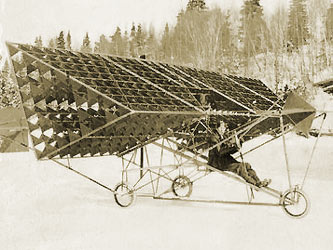 |
His aeronautical experiments |
||||||
1907 - 1919 |
John Alexander Douglas McCurdy and his friend Frederick Walker Baldwin, also known as Casey, two recent engineering graduates of the University of Toronto, decided to spend the summer in Baddec. Douglas had grown up there, and his father was the personal secretary of Dr. Bell. He had grown up close to the Bell family and is well received in their home. One day, discussing with Bell about the problems of aviation, Mabel Bell suggested them to create a formal research group to exploit their collective ideas. She realizes that her husband would need help in proving the tetrahedron's potential to the world. On 1907, June 11th, Lt. Thomas Etholen Selfridge arrives at Baddeck detailed by the United States army to observe Bell's flight experiments. In July, the American Glenn Curtiss, renowned manufacturer of engines for motorcycles and airships, brings to Bell a 40 horsepower engine. He had tried to approach the Wright Brothers, who rejected any idea of cooperation. It is therefore pleased to join the group as a specialist engine. Thus, Bell has gathered around him four young men (right picture)who are not only enthusiastic but who have the skills required to move forward his experimental work with powered flight. |
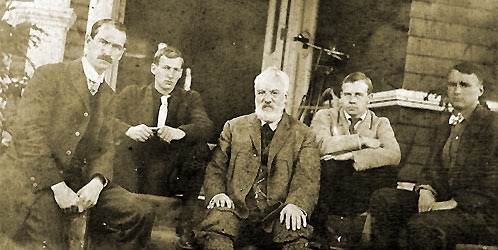 |
Bell assigned Baldwin (Casey) the job of building an observation tower composed of tetrahedral cells. As a test of strength, it was built on the summit of Beinn Bhreagh, where it was assaulted by the winds sweeping across the mountain. This three-legged iron tower was seventy-five feet high. The 4-ft. tetrahedral cells were made of half-inch iron pipe. Each cell supported 4000 pounds without stress. Furthermore, a damaged cell could easily be replaced without weakening the rest of the structure. The tower was inaugurated in August 1907. The view of the Bras d'Or Lake and surrounding area from its platform above the water is magnificent. |
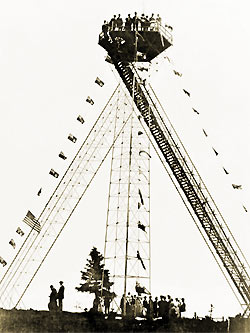 |
|
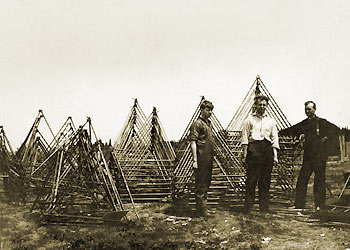 |
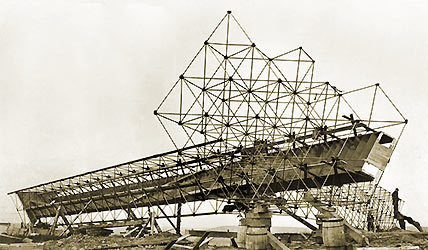 |
|
Mabel Bell proposes that the four young men and her husband form an association. Thus, the Aerial Experiment Association (AEA), a Canadian aeronautical research group is formed on 1st october 1907, under the tutelage of Alexander Graham Bell, thanks to her financing ($20,000 from the sale of a property), The initial goal of the Aerial Experimental Association is to construct “a practical flying aerodrome or flying machine driven through the air by its own power and carrying a man”. |
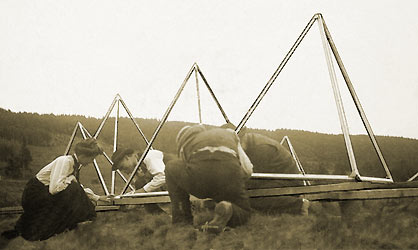 |
Alexander Graham Bell observation tower composed of tetrahedral cells, built on the ground |
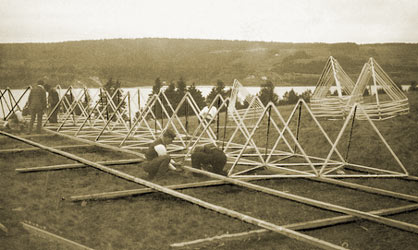 |
Bell says of this momentous occasion: « ... I think that the progress of the experiments will be greatly promoted and the world benefited if these young men who are now temporarily associated with me can be given some personal inducement to continue cooperation together in accomplishing the great object we have in common: to get into the air….” |
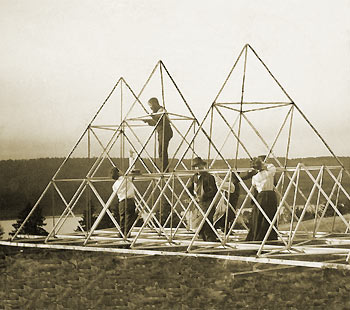 |
Baldwin, McCurdy, Selfridge and Curtiss are each invited to design their own aircraft. Their first experiments are with tetrahedral kites. Thus, the group started with one of Bell’s kites, the Cygnet I. It is an imposing cell structure with a span of 42½ feet, 208 lbs, and including 3393 silken tetrahedral cells placed on a train to skate with the driver installed very forward skates. |
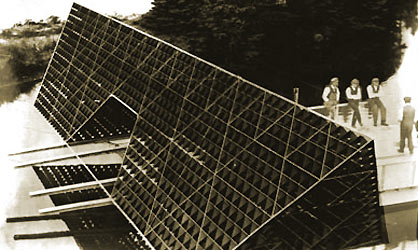 |
This first flying machine, a Bell glider, was to fly with an Curtiss engine, but Bell insists that its initial flight would be motorless. |
||
Having acquired some experience of piloting, Selfridge moved to orders, December 6 1907, to be towed by a motorboat across a lake near Baddeck, Bras d'Or Lake. |
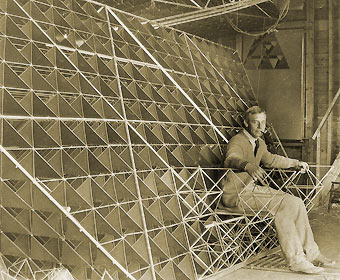 |
The machine rise approximately 165 ft high, stayed aloft for 7 minutes and then plunged into the lake, always in tow. It is seriously damaged but Selfridge is not injured. Nevertheless, Bell was extremely pleased with its performance but disappointed that it would take many months to replace. This flight is the first flight in Canada of a "heavier than air" carrying a passenger. As the Association's leader, Bell asserted that Selfridge, having risked life and limb piloting Cygnet, had earned the right to the next “aircraft”. Drome N°1 would be Selftidge's design. |
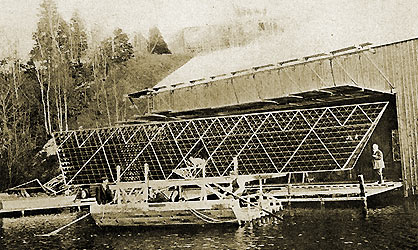 |
Aircraft cockpit tetrahedral Bell in the laboratory Nova Scotia |
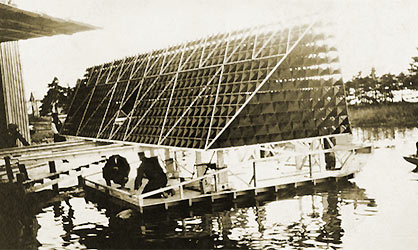 |
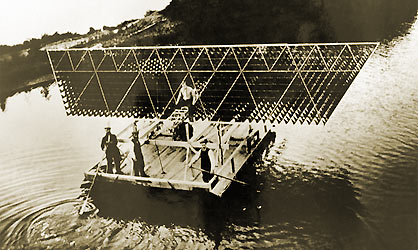 |
Winter sets in and the AEA moves their headquarters to Hammondsport, NY near Curtiss's workshop and the following devices drew substantially from the first airplanes in Europe: |
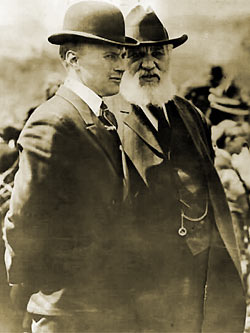 |
* Red Wing from Selfridge, allowing Baldwin (Casey) become the first Canadian pilot in March 1908. This aircraft is basically a bi-wing glider with a tail rudder, a single plane elevator up front and skid runners for take off from the ice. An engine is added with a push-type propeller. It is named for the red silk used to cover its wings. * White Wing from Baldwin, the first aircraft controlled by ailerons. It is named for its white cotton nainsook wing covering (Cloth cotton recognizable by its lightness and its similarity to silk). May 21, 1908, piloted by Glenn Curtiss, the White Wing traveled 310 meters in 19 seconds to about 3 m high. * June Bug from Curtiss was the first aircraft to officially traveled one kilometer flight in North America: July 4, 1908, aboard the June Bug, Curtis made a flight of 1,553 m and won the Scientific American Trophy, for the first straight flight of more than 1 kilometer (3,281 feet). On July 10, piloted by Curtiss, it became the first aircraft to make a complete turn. In November 1908, the June Bug, refitted with floats to convert it to a seaplane, is renamed ‘Loon'. But none of the experiments allows him to take off from the surface of Lake Keuka and the aircraft will be dismantled. Selfridge (picture left, with Bell) was killed September 17, 1908 at Fort Myer (Virginia) in the crash of a Wright piloted by Orville Wright. At a meeting held September 26th, the day after Selfridges' funeral, it is unanimously decided the AEA will continue for another six months. Mabel provides a further $10,000. Bell took the opportunity to describe the fortuitous coming together of the group and says, “We breathed an atmosphere of aviation from morning till night and almost from night to morning. Each felt the stimulation of the discussion with the others, and each developed ideas of his own upon the subject of Aviation, which were discussed by all. I may say for myself that this Association with these young men proved to be one of the happiest times of my life.” |
|
* Silver Dart from Mc Curdy, constructed similarly to the June Bug. Its tail section is shortened to facilitate turning and a bi-wing elevator is used to increase stability. By decembre 1908, the Silver Dart makes 3 trial flights of about 591 feet each, with Douglas McCurdy as pilot. Then in january 1909, the Silver Dart is shipped to Baddeck. |
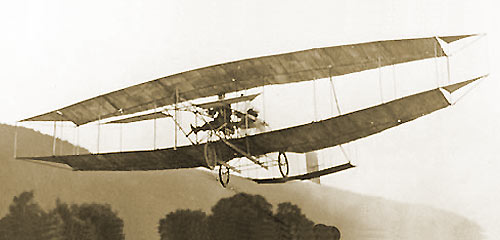 |
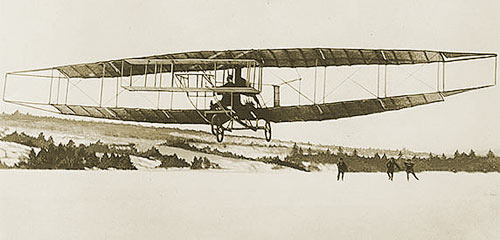 |
June Bug from Curtiss |
Silver Dart from Mc Curdy |
February 23, 1909, Red-letter day. McCurdy makes Canada's first controlled powered flight in the Silver Dart: “The Silver Dart ... rose from the ice after traveling about 100 feet & flew at an elevation of about 10-30 feet directly east for a distance of about ½ mile. Landed without any shock.. The speed I should judge about 40+ miles per hr. The machine was operated by J.A.D. McCurdy.” Home Notes, Volume 58, written by pilot J. A.D. McCurdy on Tuesday, February 23, 1909 |
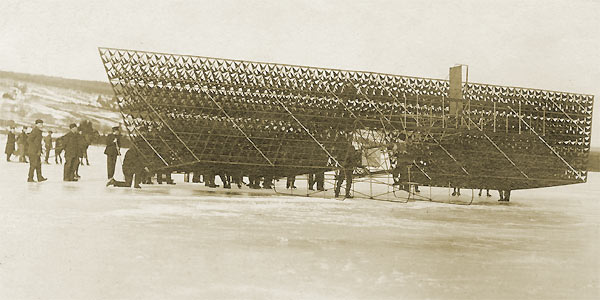 |
The Cygnet I from Bell, rebuilt and modified in a heavy tetrahedral kite of 3690 cells with an engine takes the name of Cygnet II. (left) It performs tests, february, 22-24, 1909 after receiving a tricycle landing gear. The scale was reduced to 8 m and an engine of 40 hp Curtiss V8 mounted behind the cell, but the machine refused to take off. Early 1909 the Aerial Experimental Association is slowing. Funds advanced by Ms. Bell decrease, Baldwin and Curtiss are primarily concerned with their own projects. After looking to form a corporation, the association is dissolved on 31 March 1909, Glenn Curtiss inheriting the commercial rights to the aircraft and patents, leaving Bell alone with his inquisitive airplane. April 1909, Bell encourages Baldwin and McCurdy to set up the Canadian Aerodrome Company (CAC) and its facilities in Baddeck and provides the financing. Their goal is to begin making airplanes for possible sale to the Canadian army. |
In spring 1910, the CAC explores developing floats for airplanes that would land and take off from the water and early in May, Baldwin and Bell begin their world tour.
During his world tour of 1910–1911 Bell and Baldwin met with Forlanini in Italy. They had rides in the Forlanini hydrofoil boat over Lake Maggiore. When they return to Beinn Bhreagh Baldwin designs and builds their first hydrofoil boat which they refer to as a “hydrodrome” and call it HD-1. |
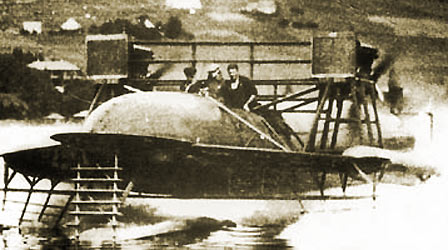 HD-4 |
Bell’s vision for a tetrahedral airplane was overshadowed by the Wright brothers’ successful biplane design. But Bell continued to work on other aircraft ideas and earned a patent in 1911 with his associates for their June Bug “flying machine.” The machine Bell, became Cygnet III after repowering with a 70 hp Gnome rotary, finally managed to take off from Bras d'Or Lake on 1 March 1912, piloted by John McCurdy, reaching 69 km/h. This is Bell's final tetrahedral kite venture. |
|
Hydrofoil experimentation continues. Bell and Baldwin develop their own hydrofoil design. Bell's report to the navy permitted him to obtain two 350 horsepower (260 kW) engines in July 1919. By September 9th, 1919, their fourth hydrodrome, HD-4, sets a world marine speed record of almost 114 kilometers (almost 71 miles) per hour. This record stood for ten years.
|
| Source : Smithsonian Institution - Fitzgerald Canada - Parks Canada - AT&T - National Geographic Magazine (Vol. XIV, No.6, June 1903) - Alexander Graham Bell National Historic Site - Dictionary of American Biography Base Set. American Council of Learned Societies, 1928-1936. Photos : Library and Archives Canada - Library of Congress American Memory - Smithsonian Institution - National Geographic |
His aeronautical experiments |
||||||
